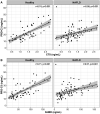PRO-C3, a Serological Marker of Fibrosis, During Childhood and Correlations With Fibrosis in Pediatric NAFLD
- PMID: 34558828
- PMCID: PMC8557318
- DOI: 10.1002/hep4.1766
PRO-C3, a Serological Marker of Fibrosis, During Childhood and Correlations With Fibrosis in Pediatric NAFLD
Abstract
Nonalcoholic fatty liver disease (NAFLD) is a common chronic liver disease in children and may lead to cirrhosis requiring liver transplant. Thus, prompt diagnosis of advanced fibrosis is essential. Our objectives were to examine PRO-C3 (a neo-epitope pro-peptide of type III collagen formation) levels across childhood/adolescence and associations with advanced fibrosis in pediatric NAFLD. This cross-sectional study included 88 children and adolescents with biopsy-proven NAFLD (mean age: 13.9 ± 2.9 years, 71% male) and 65 healthy participants (11.8 ± 4.5 years, 38% male). PRO-C3, and the bone remodeling biomarkers C-terminal telopeptide of type I collagen (CTX-I; bone resorption) and osteocalcin (N-MID; bone formation), were measured in serum by enzyme-linked immunosorbent assay. Fibrosis was assessed by liver biopsy in participants with NAFLD, who were categorized as having advanced (Ishak score ≥ 3) or none/mild fibrosis (Ishak score ≤ 2). Overall, PRO-C3 was similar in participants with NAFLD (median [interquartile range]: 20.6 [15.8, 25.9] ng/mL) versus healthy participants (19.0 [13.8, 26.0] ng/mL), but was significantly lower in older adolescents ≥ 15 years old (16.4 [13.0, 21.2] ng/mL) compared with children ≤ 10 years old (22.9 [18.1, 28.4] ng/mL; P < 0.001) or 11-14 years old (22.4 [18.3, 31.2] ng/mL; P < 0.001). PRO-C3 was also directly correlated with levels of CTX-I and N-MID (r = 0.64 and r = 0.62, respectively; both P < 0.001). Among participants with NAFLD, PRO-C3 was higher in those with advanced fibrosis (median [IQR]: 28.5 [21.6, 37.6]) compared with none/mild fibrosis (20.3 [18.2, 22.8]; P = 0.020) in models adjusted for age, sex, and body mass index z-score. However, associations were attenuated after additionally adjusting for bone-remodeling CTX-I (P = 0.09) or N-MID (P = 0.08). Conclusion: Collectively, these findings show that PRO-C3 levels are higher in children with advanced fibrosis in NAFLD, but are also influenced by age and pubertal growth spurt, assessed by bone remodeling biomarkers, and therefore may not be a reliable biomarker for liver fibrosis in pediatric NAFLD until late adolescence.
© 2021 The Authors. Hepatology Communications published by Wiley Periodicals LLC on behalf of American Association for the Study of Liver Diseases.
Figures




References
-
- Skinner AC, Perrin EM, Skelton JA. Prevalence of obesity and severe obesity in US children, 1999‐2014. Obesity 2016;24:1116‐1123. - PubMed
-
- Ekstedt M, Hagström H, Nasr P, Fredrikson M, Stål P, Kechagias S, et al. Fibrosis stage is the strongest predictor for disease‐specific mortality in NAFLD after up to 33 years of follow‐up. Hepatology 2015;61:1547‐1554. - PubMed
Publication types
MeSH terms
Substances
Grants and funding
LinkOut - more resources
Full Text Sources
Medical
Miscellaneous

